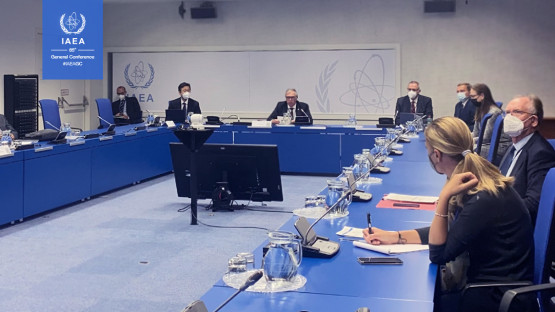Digitalization plays an important role in advancing nuclear decommissioning projects by enabling experts to improve their planning and implementation. An event held today on the side lines of the 65th IAEA General Conference highlighted the practical value of 3D modelling and simulations, visualization, virtual reality, artificial intelligence, machine learning and other similar applications in the planning and implementation of nuclear decommissioning.
Although many nuclear power reactors are undergoing life extensions, considerable decommissioning work is also underway and is expected to take place as power plants reach the end of useful and economical operations. According to IAEA projections, between 12 per cent and 25 per cent of the 2020 nuclear electrical generating capacity is expected to be retired by 2030. Effective management of decommissioning is vital to the sustainability of nuclear power.
“Innovative digital technologies can provide crucial insights for the planning and implementation of decommissioning projects. They can provide support in decommissioning situations that are difficult or dangerous for human workers and can help ensure that projects are executed safely and effectively,” Mikhail Chudakov, IAEA Deputy Director General and Head of the Department of Nuclear Energy, said in his opening remarks for the event.
Decommissioning is a multi-disciplinary process, which includes activities such as physical and radiological characterization of the site and its vicinity, and decontamination and dismantling of plant and building structures, eventually leading to the reuse of the site for some other purpose. Decommissioning may take from several years to several decades, especially in the case of deferred dismantling, and experts anticipate that digital technologies will improve planning and shorten the time period required for this complex procedure to be completed.
Digital twins of nuclear facilities, which recreate a facility’s technology and structures, are increasingly used to support effective design, operation and maintenance. Digital twins can be used as “as-built records”, detailing how exactly a nuclear facility was constructed and maintained during its operation, to support the planning and implementation of decommissioning. Digitization also helps to enhance safety: It enables the analysis of different dismantling scenarios in terms of radiation exposure of workers, so that the safest one can be selected.
So far, a total of 189 nuclear power reactors have been shut down for decommissioning globally, with 17 of them fully decommissioned. In addition, 130 fuel cycle facilities have been decommissioned as well as about 440 research reactors.
More than 80 people attended the event online to hear experts present practical examples of how digital technologies have been applied in decommissioning projects.
“Benefits of using digital information models include significant increase of work quality and productivity thanks to improved planning, simulation of deployment of different types of equipment and the possibility of promptly changing project parameters,” said Daria Daubaraite, Decommissioning Project Manager at Rosatom/TVEL in Russia.
3D modelling and simulations can be used in the planning stages of nuclear facility dismantling. Italy’s Decommissioning and Radioactive Waste Management Company (SOGIN) has used 3D models and simulations to facilitate preparation of the dismantling of different types of power reactors as well as for IT-supported management of generated waste streams.
In 2019, SOGIN was designated as an IAEA Collaborating Centre, strengthening cooperation between the two organizations, including on digitalization, to promote knowledge management, knowledge transfer and training in nuclear decommissioning.
The Slovak Nuclear and Decommissioning Company (JAVYS), an IAEA Collaborating Centre on nuclear facility decommissioning and radioactive waste management, has also used 3D modelling and simulations to support dismantling of WWER reactors components at the Bohunice V1 nuclear power plant in western Slovakia. JAVYS used these techniques to determine and prove the best strategy for cutting primary circuit components that needed to be dismantled and to design tools for retrieval, transport and cutting activities.
“3D modelling and simulations of dismantling interventions significantly contribute to the planning accuracy of the decommissioning process and facilitate our discussions with the regulators,” said Tibor Kukan of JAVYS. “Moreover, simulations are an effective tool for supporting communication with the public.”
Advanced data science has been successfully used to support decommissioning and environmental remediation. Leo Lagos, Director of Research at Florida International University, discussed how this is currently being done at US Department of Energy sites.
“Artificial intelligence and machine learning technologies are being used for everything from structural health monitoring of decommissioning infrastructure to ongoing surveillance and maintenance across the Department of Energy complex to support the assessment of structural integrity in aging nuclear facilities,” said Lagos.
To continue the exchange of information on decommissioning, the IAEA will host the International Conference on Nuclear Decommissioning: Addressing the Past and Ensuring the Future in Vienna in May 2023. The objective of the conference is to share information on achievements, challenges and lessons learned as well as on the strategies and approaches that can enable and enhance safe, secure and cost-effective implementation of national decommissioning programmes.







